![]()
![]()
![]()
Use LEFT and RIGHT arrow keys to navigate between flashcards;
Use UP and DOWN arrow keys to flip the card;
H to show hint;
A reads text to speech;
35 Cards in this Set
- Front
- Back
|
Vascular Plants |
Have vascular vessels to transport water and food throughout the plant. Within vascular plants is the phloem, the vessel that transports food, and the xylem, which transports water Have roots not only for support but also to soak up water that is farther away from the plant. |
|
|
Nonvascular |
Simple plants without a vascular system Nonvascular plants are very small because their lack of a vascular system means they do not have the mechanics required for transporting food and water far distances They lack roots, instead nonvascular plants have rhizoids, which are small hairs that insert into the substrate to keep the plant in place Nonvascular plants are commonly found in moist environments so that they are always close to a water source and can absorb the water right into the main part of the plant without relying on roots Most nonvascular plants reproduce sexually by creating single-celled spores or asexually by vegetative propagation. Vegetative propagation (asexual reproduction) is when part of the plant breaks off and develops into a new plant with the exact same genetic information as the original plant. Also called Bryophytes 1. Mosses 2. Hornworts 3. Liverworts |
|
|
Mosses |

Are the nonvascular plants that are most commonly seen covering the forest floor or covering the trunks of trees. Most mosses have a short central stem with wiry branches and very small leaf-like structures. These bryophytes often look soft and cushiony, or they can also resemble feathers. Some mosses can survive complete dehydration and then rehydrate when water is available again. |
|
|
Hornworts |
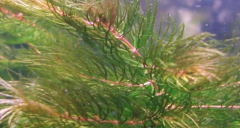
Have thin branch-like structures and leaves that look similar to soft pine needles. These bryophytes prefer very moist environments, and some are even found submerged in ponds and lakes. Submerged hornworts can grow larger than mosses and liverworts because the water provides them with support and structure. |
|
|
Liverworts |
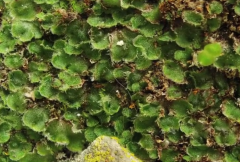
Are often called the simplest plant. They are commonly identified by flattened leaves that often grow in two distinctive rows. Due to their flattened leaves, liverworts grow very low to the ground and form large mats over the surface. They can be found in terrestrial or semi-aquatic environments and are often referred to as weeds because they can easily take over farm land if the land is moist enough. |
|
|
Importance of Nonvascular Plants |
There are some species of mosses that can absorb and hold up to seven times their weight in water. This ability to absorb water can be very beneficial because it helps maintain a moist environment. Some nonvascular plants produce various nutrients that are passed to the soil and can be used by other plants. Also, nonvascular plants that cover a large surface area help maintain the cohesion of the land by reducing the risk of erosion. Nonvascular plants are also very important to animals. Insects are known to use nonvascular plants for shelter. Many species of birds also are known to use nonvascular plants, especially mosses, as building material for their nests. |
|
|
Gymnosperms |
Are vascular plants that create cones to house their seeds. Common gymnosperms include large trees, such as cedars, hemlocks, pines, and spruces. |
|
|
Ferns |
Vascular plants that reproduce by the use of spores This type of vascular plant is often referred to as a seedless vascular plant. |
|
|
Angiosperms |
Are vascular plants that create their seeds inside fruits or flowers and are often referred to simply as flowering plants. Some common examples of angiosperms include sunflowers, dogwood trees, elm trees, lilies, and maple trees. Furtherly Divided 1. Monocots 2. Eudicots |
|
|
Monocot |
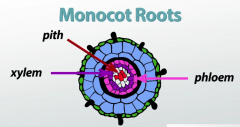
Are known for having one original leaf from their seed, parallel veins in their leaves, flower parts in multiples of three, and a fibrous root system. Have a more complex arrangement with bundles of vascular vessels spread throughout the entire plant |
|
|
Eudicots (Dicot) |
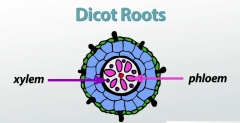
Vary from monocots because they have two original leaves from their seed, branched veins, flower parts in multiples of four or five, and a taproot. Have their vascular vessels arranged in a ring towards the outside edge of the plant |
|
|
Tropism |
The response to a stimulus Positive Tropism: when the movement is towards the stimulus Negative Tropism: when the movement is away from the stimulus |
|
|
Phototropism |
Response to sunlight |
|
|
Geotropism |
Movement toward or away from the earth |
|
|
Thigmatropism |
Is the movement towards or away from touch |
|
|
Fungi |
A group of eukaryotic, non-phototrophic organisms with rigid cell walls (made from chitin), that includes mushrooms, molds and yeasts |
|
|
Saprophytes |
An organism that acquires nutrients from dead organic matter |
|
|
Mushrooms |
Usually found springing up on dead wood after cool, wet weather, the mushroom is a common sight. Mushrooms generally consist of a stalk with a large cap on top. This cap produces the spores that the mushroom releases in order to reproduce and colonize new environments. Many species of mushrooms are edible and delicious, but others can be very toxic. |
|
|
Mold |
Forget about that brick of cheddar cheese for too long and suddenly it's covered with green fuzz. That fuzz is why molds are often called filamentous fungi, and the filaments give it that fuzzy or fluffy appearance. Hyphae is a technical term for the long, branching mold filaments |
|
|
Yeast |
Unicellular fungus Yeasts reproduce by budding. The new offspring cell begins as a small outgrowth on the membrane of the parent cell, which gets larger before eventually pinching off. This process is asexual, resulting in two clones Yeasts are unicellular, yet eukaryotic, making them an important group of organisms for scientists |
|
|
Mycosis |
Is the term given to any illness caused by the growth of a fungus either on or inside the body. There are several important human diseases caused by fungi, but they usually infect the body surfaces or respiratory tract and are rarely serious for healthy individuals. It's a good thing, too, because fungal infections can be difficult to eliminate. As a fellow eukaryote, most of the medications that will kill a fungus are also toxic to human cells, often producing nasty side effects. |
|
|
Chytridiomycetes |
Thought to be the oldest group of fungi. We often find these fungi in lakes, ponds, estuaries and soil. Many species in this group are decomposers, meaning that they break down dead organic material. But other species are parasites of plants and animals and are responsible for many infections in amphibians. |
|
|
Zygomycetes |
Some fungi in this group are fast-growing molds, such as black bread mold and molds that rot the fruit you left sitting out on the counter too long. So, should you eat that rotting fruit? I wouldn't go near it! |
|
|
Glomeromycetes |
Fungi 90% of plants form symbiotic relationships with glomeromycetes, which help deliver nutrients to the plant while receiving other necessary nutrients in return. Like a 'conglomerate' is multiple parts combined together, Glomeromycetes combine with plants to form a strong team. |
|
|
Ascomycetes |
Known as 'sac' fungi These live in a wide variety of habitats (marine, freshwater and terrestrial) and can range in size from unicellular yeast to fancy morel mushrooms (yum!). Not always the good guy though, Ascomycetes are also some of the most devastating plant pathogens. |
|
|
Basidiomycetes |
Also known as 'club' fungus This is what most people imagine when they hear the word 'fungus' because these are many of the mushrooms, puffballs and shelf fungi. They get their name from their club-like reproductive structure called a 'basidium,' |
|
|
Mold |
Is simply any rapidly growing fungus that produces spores asexually |
|
|
Lichen |
Are a symbiotic partnership of fungi and photosynthetic organisms. In this case, the photosynthetic organisms are photosynthetic algae and cyanobacteria, and you've seen this as different forms of moss. |
|
|
Mycorrhiza |
Is a symbiotic relationship between plant roots and fungi. The term 'mycorrhiza' literally means 'fungus root.' The fungi in this relationship surround the plant root but don't penetrate the cells. The fungi absorb nutrients from the soil and share them with the plant. In return, the plant provides sugars from photosynthesis to the fungi, making them both happy campers |
|
|
Characteristics of Angiosperms |
Flowers: serve as the reproductive organs for the plant Small pollen grains: this small size allows the process of fertilization to occur quicker in the flowers of angiosperms and makes them more efficient at reproducing Stamens: are the reproductive structures found in flowers that produce the pollen grains that carry the male genetic information Smaller female reproductive parts: than non-flowering plants, allowing them to produce seeds more quickly. Carpels: that enclose developing seeds that may turn into a fruit Endosperm: is a material that forms after fertilization and serves as a highly nutritional food source for the developing seed and seedling. |
|
|
Stomata |
Open and close to allow the intake of carbon dioxide and the release of oxygen |
|
|
Transpiration |
Process of plant water loss |
|
|
Guard Cells |
They are triggered by a number of factors, such as sunlight, humidity, temperature, and internal plant chemistry. Surrounding each stoma |
|
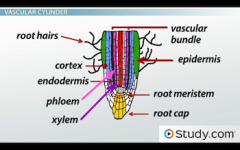
|
Root Cap: protects other root tissues as the root continues to grow into the soil,they can sense gravity, and secrete a slimy substance that helps roots move through the soil
Root Meristem: when the root grows, the new cells come from the root meristem Epidermis: protective outer layer Root Hairs: are the main site of water and nutrient absorption. Root hairs allow for greater surface area so that plants can take in more vital substances Cortex: food storage, the tasty parts of a root -- carrot or radishes Endodermis:this structure contains fatty substances that block water Vascular Cylinder: contains xylem and phloem
|
|
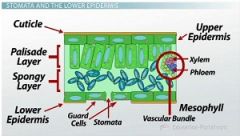
|
Cuticle: generally waxy to protect the leaf and prevent water loss Epidermis:helps protect the leaf by aiding in preventing water loss and providing an extra layer between the outside and inside of the leaf Chloroplasts: cell structures that allow for photosynthesis Spongy Layer: the large air pockets allow for gas exchange between different areas of the leaf Vascular Bundles:contain xylem (water moving up) and phloem (sugar moving down) |

